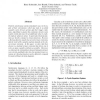Free Online Productivity Tools
i2Speak
i2Symbol
i2OCR
iTex2Img
iWeb2Print
iWeb2Shot
i2Type
iPdf2Split
iPdf2Merge
i2Bopomofo
i2Arabic
i2Style
i2Image
i2PDF
iLatex2Rtf
Sci2ools
ACSD
2005
IEEE
2005
IEEE
Maximal Causality Analysis
Perfectly synchronous systems immediately react to the inputs of their environment, which may lead to so-called causality cycles between actions and their trigger conditions. Algorithms to analyze the consistency of such cycles usually extend data types by an additional value to explicitly indicate unknown values. In particular, Boolean functions are thereby extended to ternary functions. However, a Boolean function usually has several ternary extensions, and the result of the causality analysis depends on the chosen ternary extension. In this paper, we show that there always is a maximal ternary extension that allows one to solve as many causality problems as possible. Moreover, we elaborate the relationship to hazard elimination in hardware circuits, and finally show how the maximal ternary extension of a Boolean function can be efficiently computed by means of binary decision diagrams.
Related Content
| Added | 24 Jun 2010 |
| Updated | 24 Jun 2010 |
| Type | Conference |
| Year | 2005 |
| Where | ACSD |
| Authors | Klaus Schneider, Jens Brandt, Tobias Schüle, Thomas Tuerk |
Comments (0)

